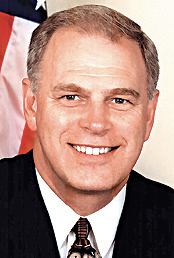Strickland’s staff built case against Dann
By MARK NIQUETTE

Ohio Governor Ted Strickland (D-Lisbon)

Former Ohio Attorney General Marc Dann
The governor’s legal staff prepared a detailed presentation on Dann.
COLUMBUS — Not only did Gov. Ted Strickland call for the resignation or impeachment of fellow Democrat and former Attorney General Marc Dann last month, the governor’s legal staff also helped prepare the case to force Dann from office if necessary, newly unveiled records show.
That included a detailed PowerPoint presentation outlining the legal framework for impeachment and documenting examples of Dann’s “gross immorality” and “gross neglect of duty,” according to correspondence to and from the governor’s office requested by The Dispatch.
Strickland’s legal staff also produced a side-by-side comparison of testimony that Dann gave under oath and “conflicting testimony” from others who were interviewed.
Dann ultimately decided to resign on May 14 after articles of impeachment were filed against him in the Ohio House and the Ohio inspector general raided his office in the wake of allegations of sexual harassment and mismanagement.
The correspondence shows that Dann had trouble accessing an electronic version of the sharply worded May 4 letter from Strickland and other statewide Democrats demanding that he resign or face impeachment.
“I can’t open the attachment,” Dann wrote to John Haseley, Strickland’s chief of staff, at 6:34 a.m. on May 5.
“Is there a fax number I can use?” Haseley writes back about an hour later.
The e-mails and other correspondence show that when Dann initially refused to quit after the scandal broke, Kent Markus, Strickland’s chief legal counsel, and other legal staffers worked with House Democrats to begin compiling the arguments that could be used to oust him.
The governor was committed to having Dann leave office; the PowerPoint presentation was created as a way to compile the various elements of research and discussions taking place, Strickland spokesman Keith Dailey said.
“The intent was to outline a very well-reasoned and strong case for impeachment,” Dailey said.
For example, the documents list Dann’s affair with his scheduler, Jessica Utovitch, as evidence of “gross immorality.” The records noted that although Dann swore that he was not aware of Utovitch’s transfer to another job and pay raise, Dann’s former chief of staff testified that “Marc and I had several conversations about Utovitch and accepting the travel job.”
Dann insisted that he had committed no crime or impeachable offense, but the lawyers argued that the standard for impeachment in Ohio is not crimes but rather misconduct in office as determined by the General Assembly.
They said that Dann undermined the integrity of the office, brought disrepute on it, betrayed his trust as a chief law enforcement officer, undermined the effectiveness and efficiency of the office and “subverted [the] rule of law and justice.”
The records also show that Strickland’s office received suggestions about whom the governor should appoint to replace Dann after he resigned. Former Ohio Supreme Court Justice Andy Douglas even offered his services.
“If you need someone to go into the AG’s office to clean up the mess before your choice arrives, I would be willing to do whatever you need,” Douglas, a Republican who is now executive director of the Ohio Civil Service Employees Association, wrote in a May 22 e-mail to Haseley.
Six days later, Strickland named Nancy H. Rogers, dean of the Moritz College of Law at Ohio State University, to serve as attorney general until an election is held Nov. 4 for the remainder of Dann’s term.
 43
43
